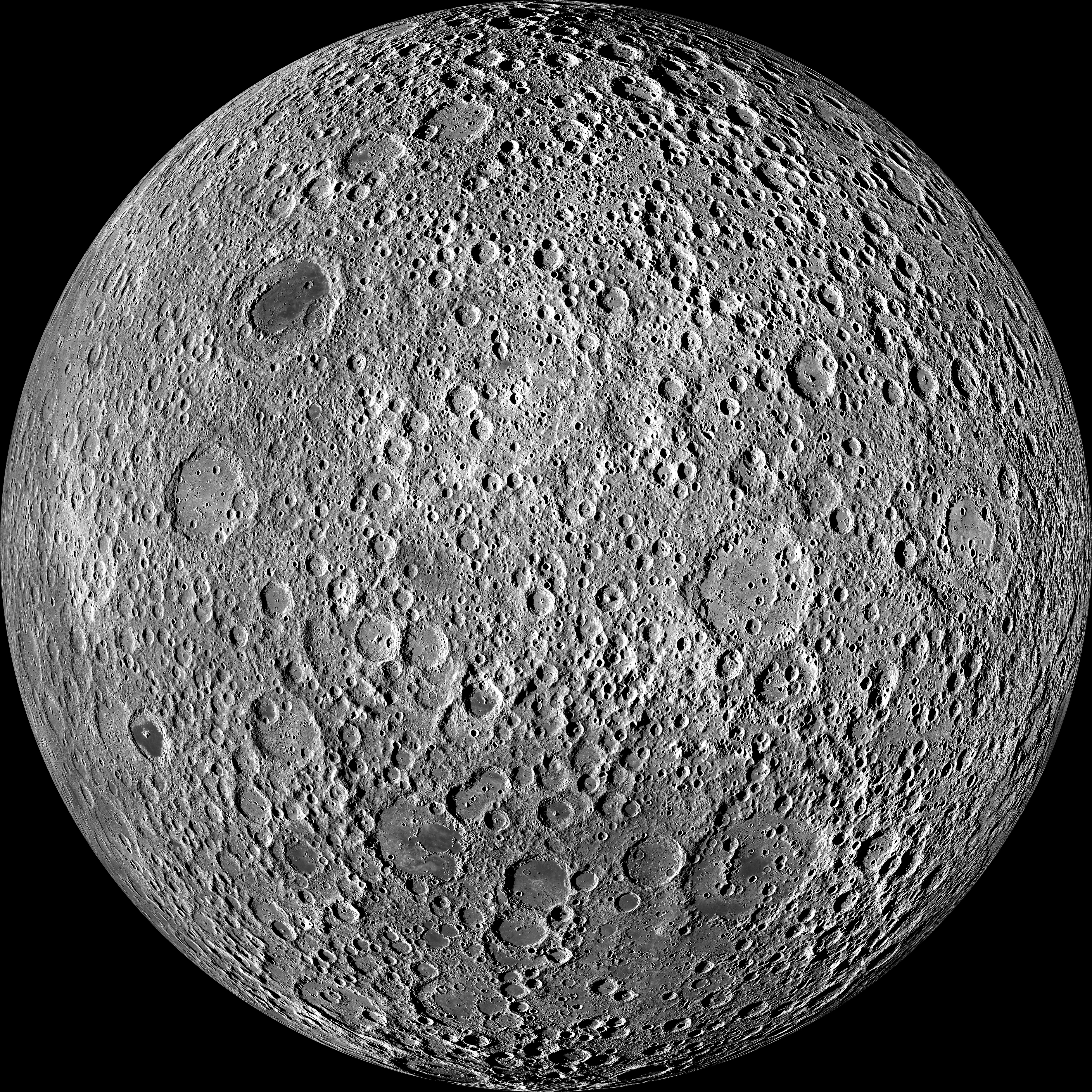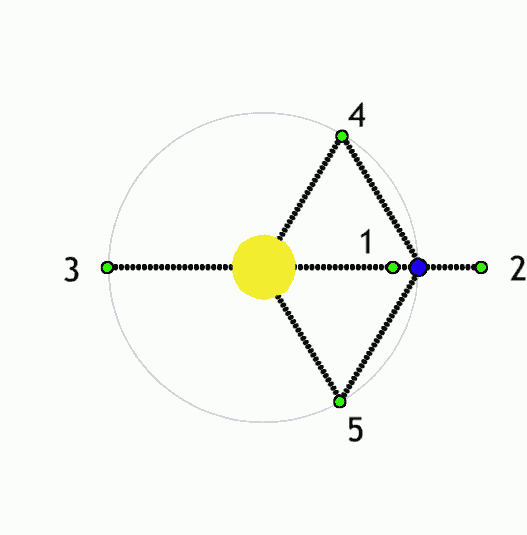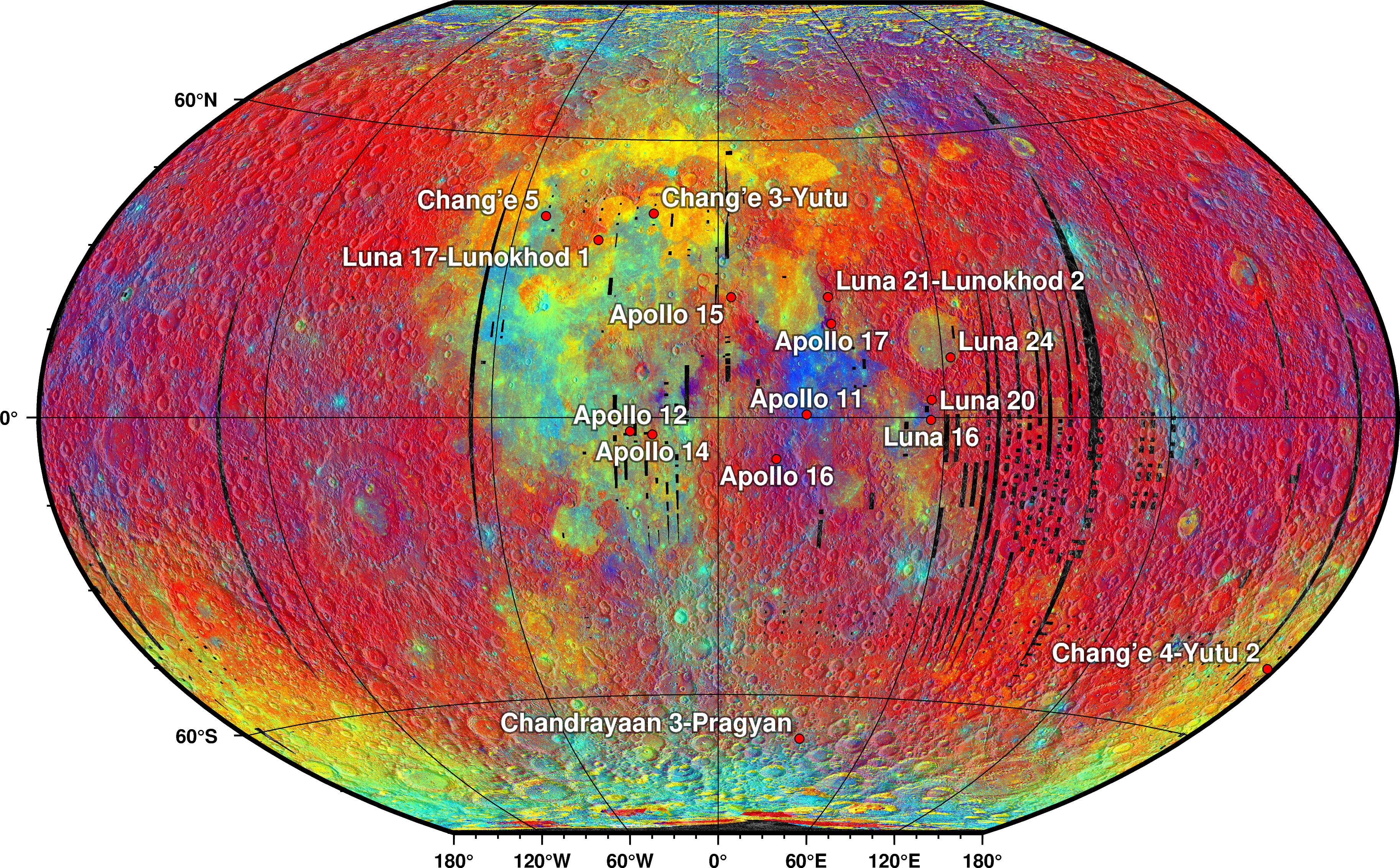|
Chang'e-4
Chang'e 4 (; ) is a robotic spacecraft mission, part of the second phase of the Chinese Lunar Exploration Program. China achieved humanity's first soft landing on the far side of the Moon, on 3 January 2019. A communication relay satellite, , was first launched to a halo orbit near the Earth–Moon L2 point in May 2018. The robotic lander and '' Yutu-2'' () rover were launched on 7 December 2018 and entered lunar orbit on 12 December 2018, before landing on the Moon's far side. The mission is the follow-up to Chang'e 3, the first Chinese landing on the Moon. The spacecraft was originally built as a backup for Chang'e 3 and became available after Chang'e 3 landed successfully in 2013. The configuration of Chang'e 4 was adjusted to meet new scientific and performance objectives. Like its predecessors, the mission is named after Chang'e, the Chinese Moon goddess. In November 2019, Chang’e 4 mission team was awarded Gold Medal by the Royal Aeronautical Society. In Octobe ... [...More Info...] [...Related Items...] OR: [Wikipedia] [Google] [Baidu] |
Far Side Of The Moon
The far side of the Moon is the lunar hemisphere that always faces away from Earth, opposite to the Near side of the Moon, near side, because of synchronous rotation in the Moon's orbit. Compared to the near side, the far side's terrain is rugged, with a multitude of impact craters and relatively few flat and dark lunar mare, lunar maria ("seas"), giving it an appearance closer to other barren places in the Solar System such as Mercury (planet), Mercury and Callisto (moon), Callisto. It has one of the largest craters in the Solar System, the South Pole–Aitken basin. The hemisphere is sometimes called the "dark side of the Moon", where "dark" means "unknown" instead of "lacking sunlight" each side of the Moon experiences two weeks of sunlight while the opposite side experiences two weeks of night. About 18 percent of the far side is occasionally visible from Earth due to libration. The remaining 82 percent remained unobserved until 1959, when it was photographed by the Sovie ... [...More Info...] [...Related Items...] OR: [Wikipedia] [Google] [Baidu] |
Yutu-2
''Yutu-2'' is the robotic lunar rover component of China National Space Administration, CNSA's Chang'e 4 mission to the Moon, launched on 7 December 2018 18:23 UTC, it entered lunar orbit on 12 December 2018 before making the first soft landing on the far side of the Moon on 3 January 2019. ''Yutu-2'' is currently operational as the longest-lived lunar rover and the first lunar rover traversing the far side of the Moon. By January 2022, ''Yutu-2'' had travelled a distance of more than along the Moon's surface. Overview The total landing mass is . Both the stationary lander and ''Yutu-2'' rover are equipped with a radioisotope heater unit (RHU) in order to heat their subsystems during the long lunar nights,China Shoots for the Moon's Far Side (PDF) IEEE.org. 2018. while electrical power i ... [...More Info...] [...Related Items...] OR: [Wikipedia] [Google] [Baidu] |
Queqiao Relay Satellite
''Queqiao'' relay satellite (), also known as the Chang'e 4 Relay, is a communications relay and radio astronomy satellite for the Chang'e 4 lunar farside mission. As part of the Chinese Lunar Exploration Program, the China National Space Administration (CNSA) launched the Queqiao relay satellite on 20 May 2018 to a halo orbit around the Earth–Moon L2 Lagrangian point Queqiao is the first ever communication relay and radio astronomy satellite at this location. The name ''Queqiao'' ("Magpie Bridge") was inspired by and came from the Chinese tale ''The Cowherd and the Weaver Girl''. Design and development Queqiao was designed to function as a communication relay for the Chang'e 4 mission to the far side of the Moon, as well as a deep space radio astronomy observatory for the Chinese space program. Direct communication with Earth is impossible on the far side of the Moon, since transmissions are blocked by the Moon. Communications must go through a communications relay satel ... [...More Info...] [...Related Items...] OR: [Wikipedia] [Google] [Baidu] |
Halo Orbit
A halo orbit is a periodic, three-dimensional orbit near one of the L1, L2 or L3 Lagrange points in the three-body problem of orbital mechanics. Although a Lagrange point is just a point in empty space, its peculiar characteristic is that it can be orbited by a Lissajous orbit or a halo orbit. These can be thought of as resulting from an interaction between the gravitational pull of the two planetary bodies and the Coriolis and centrifugal force on a spacecraft. Halo orbits exist in any three-body system, e.g., a Sun–Earth–orbiting satellite system or an Earth–Moon–orbiting satellite system. Continuous "families" of both northern and southern halo orbits exist at each Lagrange point. Because halo orbits tend to be unstable, stationkeeping may be required to keep a satellite on the orbit. Most satellites in halo orbit serve scientific purposes, for example as space telescopes. Definition and history Robert W. Farquhar first used the name "halo" in 1966 for orbits arou ... [...More Info...] [...Related Items...] OR: [Wikipedia] [Google] [Baidu] |
Lunar Rover
A lunar rover or Moon rover is a space exploration vehicle designed to move across the surface of the Moon. The Apollo Program's Lunar Roving Vehicle was driven on the Moon by members of three American crews, Apollo 15, 16, and 17. Other rovers have been partially or fully autonomous robots, such as the Soviet Union's Lunokhods and the Chinese '' Yutus''. Three countries have had operating rovers on the Moon: the Soviet Union, the United States and China. An Indian mission failed while Japan and Greece currently have planned missions. Past missions Lunokhod 1 Lunokhod 1 (Луноход) was the first of two polycrystalline-panel-powered robotic lunar rovers landed on the Moon by the Soviet Union as part of its Lunokhod program after a previous unsuccessful attempt of a launch probe with Lunokhod 0 (No.201) in 1969. The spacecraft which carried Lunokhod 1 was named Luna 17. The spacecraft soft-landed on the Moon in the Sea of Rains on November 1970. Lunokhod was the first ... [...More Info...] [...Related Items...] OR: [Wikipedia] [Google] [Baidu] |
Lagrange Point
In celestial mechanics, the Lagrange points (; also Lagrangian points or libration points) are points of equilibrium for small-mass objects under the influence of two massive orbiting bodies. Mathematically, this involves the solution of the restricted three-body problem in which two bodies are far more massive than the third. Normally, the two massive bodies exert an unbalanced gravitational force at a point, altering the orbit of whatever is at that point. At the Lagrange points, the gravitational forces of the two large bodies and the centrifugal force balance each other. This can make Lagrange points an excellent location for satellites, as few orbit corrections are needed to maintain the desired orbit. Small objects placed in orbit at Lagrange points are in equilibrium in at least two directions relative to the center of mass of the large bodies. For any combination of two orbital bodies there are five Lagrange points, L1 to L5, all in the orbital plane of the two lar ... [...More Info...] [...Related Items...] OR: [Wikipedia] [Google] [Baidu] |
Lagrangian Point
In celestial mechanics, the Lagrange points (; also Lagrangian points or libration points) are points of equilibrium for small-mass objects under the influence of two massive orbiting bodies. Mathematically, this involves the solution of the restricted three-body problem in which two bodies are far more massive than the third. Normally, the two massive bodies exert an unbalanced gravitational force at a point, altering the orbit of whatever is at that point. At the Lagrange points, the gravitational forces of the two large bodies and the centrifugal force balance each other. This can make Lagrange points an excellent location for satellites, as few orbit corrections are needed to maintain the desired orbit. Small objects placed in orbit at Lagrange points are in equilibrium in at least two directions relative to the center of mass of the large bodies. For any combination of two orbital bodies there are five Lagrange points, L1 to L5, all in the orbital plane of the two lar ... [...More Info...] [...Related Items...] OR: [Wikipedia] [Google] [Baidu] |
Lander (spacecraft)
A lander is a spacecraft that descends towards, comes to rest on, the surface of an astronomical body. In contrast to an impact probe, which makes a hard landing that damages or destroys the probe upon reaching the surface, a lander makes a soft landing after which the probe remains functional. For bodies with atmospheres, the landing occurs after atmospheric entry. In these cases, landers may employ parachutes to slow them down enough to maintain a low terminal velocity. In some cases, small landing rockets will be fired just before impact in order to reduce the lander's velocity. Landing may be accomplished by controlled descent and set down on landing gear, with the possible addition of a post-landing attachment mechanism (such as the mechanism used by ''Philae'') for celestial bodies with low gravity. Some missions (for example, Luna 9 and Mars Pathfinder) used inflatable airbags to cushion the lander's impact rather than utilizing more traditional landing gear. When a hi ... [...More Info...] [...Related Items...] OR: [Wikipedia] [Google] [Baidu] |
Perilune
An apsis (; ) is the farthest or nearest point in the orbit of a planetary body about its primary body. For example, the apsides of the Earth are called the aphelion and perihelion. General description There are two apsides in any elliptic orbit. The name for each apsis is created from the prefixes ''ap-'', ''apo-'' (), or ''peri-'' (), each referring to the farthest and closest point to the primary body the affixing necessary suffix that describes the primary body in the orbit. In this case, the suffix for Earth is ''-gee'', so the apsides' names are ''apogee'' and ''perigee''. For the Sun, its suffix is ''-helion'', so the names are ''aphelion'' and ''perihelion''. According to Newton's laws of motion, all periodic orbits are ellipses. The barycenter of the two bodies may lie well within the bigger body—e.g., the Earth–Moon barycenter is about 75% of the way from Earth's center to its surface. If, compared to the larger mass, the smaller mass is negligible (e.g., f ... [...More Info...] [...Related Items...] OR: [Wikipedia] [Google] [Baidu] |
Chang'e 6
Chang'e 6 () is a planned robotic Chinese lunar exploration mission that is expected to launch in 2025 and perform China's second sample return mission. Like its predecessors, the spacecraft is named after the Chinese moon goddess Chang'e. Overview The Chinese Lunar Exploration Program is designed to be conducted in fourChang'e 4 press conference CNSA, broadcast on 14 January 2019. phases of incremental technological advancement: The first is reaching lunar orbit, completed by Chang'e 1 in 2007 and Chang'e 2 in 2010. The second is landing and roving on the Moon, as Chang'e 3 did in 2013 and [...More Info...] [...Related Items...] OR: [Wikipedia] [Google] [Baidu] |
Chang'e 2
Chang'e 2 (; ) is a Chinese unmanned lunar probe that was launched on 1 October 2010. It was a follow-up to the Chang'e 1 lunar probe, which was launched in 2007. Chang'e 2 was part of the first phase of the Chinese Lunar Exploration Program, and conducted research from a 100-km-high lunar orbit in preparation for the December 2013 soft landing by the Chang'e 3 lander and rover. Chang'e 2 was similar in design to Chang'e 1, although it featured some technical improvements, including a more advanced onboard camera. Like its predecessor, the probe was named after Chang'e, an ancient Chinese moon goddess. After completing its primary objective, the probe left lunar orbit for the Earth–Sun Lagrangian point, to test the Chinese tracking and control network, making the China National Space Administration the third space agency after NASA and ESA to have visited this point. It entered orbit around L2 on 25 August 2011, and began transmitting data from its new position in September 201 ... [...More Info...] [...Related Items...] OR: [Wikipedia] [Google] [Baidu] |
Moon Farside LRO 5000
The Moon is Earth's only natural satellite. It is the fifth largest satellite in the Solar System and the largest and most massive relative to its parent planet, with a diameter about one-quarter that of Earth (comparable to the width of Australia). The Moon is a planetary-mass object with a differentiated rocky body, making it a satellite planet under the geophysical definitions of the term and larger than all known dwarf planets of the Solar System. It lacks any significant atmosphere, hydrosphere, or magnetic field. Its surface gravity is about one-sixth of Earth's at , with Jupiter's moon Io being the only satellite in the Solar System known to have a higher surface gravity and density. The Moon orbits Earth at an average distance of , or about 30 times Earth's diameter. Its gravitational influence is the main driver of Earth's tides and very slowly lengthens Earth's day. The Moon's orbit around Earth has a sidereal period of 27.3 days. During each s ... [...More Info...] [...Related Items...] OR: [Wikipedia] [Google] [Baidu] |





.png)